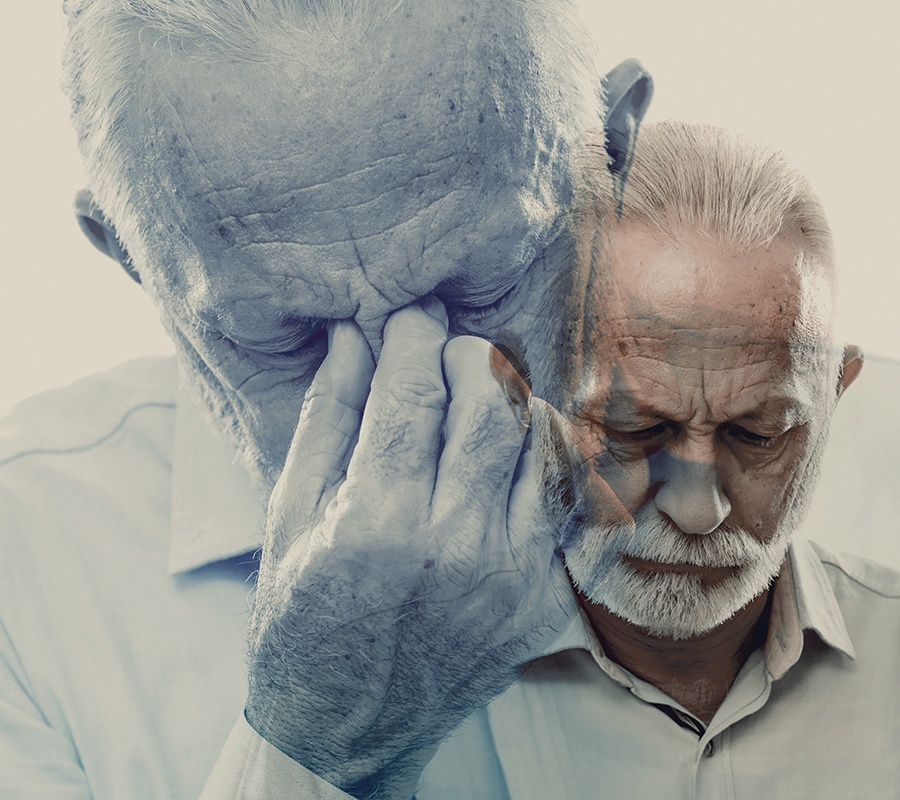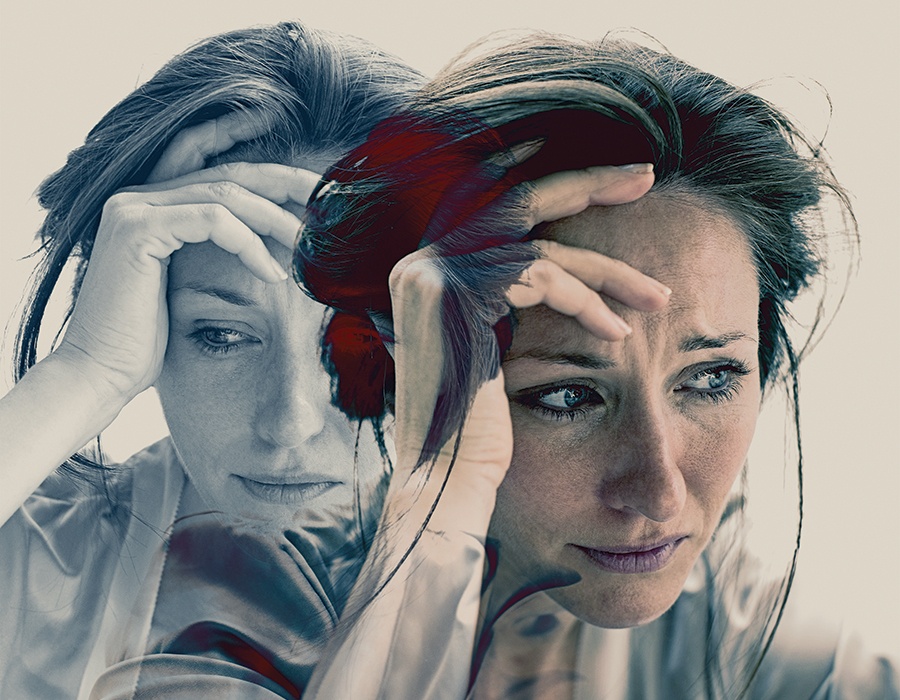Inside Boston’s Looming Mental Health Crisis
Depressed. Anxious. Stressed. We were all of these things even before the pandemic hit. Now, facing a long winter of isolation and uncertainty, Bostonians are increasingly finding themselves at their breaking point. A special report on the area’s looming mental health crisis—and how to find help if you need it.
Read more about Boston’s mental health crisis

Photo illustration by Benjamen Purvis / Getty/iStock/Media photos
If I asked how you are doing today, how would you answer? You might say “pretty well”—after all, you’ve probably already ticked a lot of things off your to-do list—shopping, cooking, helping the kids with remote classes, doing those Zoom calls like a boss, weightlifting on the porch, dropping in on your friend’s virtual cocktail hour. But dig a little deeper. Have you smiled—like, really smiled? Have you laughed? Have you been able to find joy in things big or small?
If the answer is no, you’re hardly alone. On August 21, the well-known journalist and pundit Molly Jong-Fast tweeted: “I don’t think we’re talking enough about the emotional effect the pandemic is having on us all.” In just 24 hours, 55,000 people had clicked the “like” button on her tweet, and nearly 2,000 followed up with their own mental health stories, many a gut-wrenching snapshot of 2020 pain told in 280 characters or fewer. They were brief, a knife to the heart: “I cry almost every other day,” wrote one person. Some revealed our collective fragility: “One little thing…like a sudden home repair…or a big thing…like a hurricane…suddenly brings your emotional state into a spotlight.” An alarming number of people expressed dangerous ideations: “I’ve never been closer to self-harm than I have been in this past month, after a lifetime of trying to cultivate a sense of optimism, kindness, and solidarity with my fellow man regardless of their differences. It’s taking a toll, that’s for sure.” In one simple tweet, Jong-Fast had triggered an outpouring of real, raw emotional pain.
We are not okay. The kids are not all right. The coronavirus pandemic has taken a massive toll on our mental well-being across every demographic, age group, economic level, and region. A CDC report revealed that as of late June, about 25 percent of adults in the United States reported symptoms of anxiety disorder. That’s triple the rate in 2019. According to the same report, one in four young adults ages 18 to 24 had seriously considered suicide in the past month; unpaid caregivers and essential workers also reported high rates of suicidal thoughts. In fact, more than half of U.S. adults in a Kaiser Family Foundation poll conducted in July said their mental health has been “negatively impacted due to worry and stress over the coronavirus.” In short, we are barreling toward a second pandemic, a collective PTSD, a mental health reckoning.
Fortunately, Massachusetts is in a better position than most states to deal with the huge number of people already in treatment for mental health issues: The state has a long history of forward-thinking policies dating back to landmark legislation passed in 1966 that greatly expanded outpatient and community-based mental health facilities and services. In 2017, we had about 50 behavioral healthcare providers per 10,000 residents—the highest ratio in the United States.
The Silent Crisis
A sobering look at the Bay State’s numbers.
19.6%
Depression rate in Massachusetts pre-COVID
363,000
Number of adults in the state reporting unmet need for mental health treatment from 2017 to 2018
$8.9 billion
The economic burden of serious mental illness, including lost productivity and medical costs, in 2018
50
Number of behavioral health providers per 10,000 residents in the Massachusetts—the highest in the U.S.
27%
Percentage of the state prison population previously diagnosed with a serious mental illness
131%
Percent increase in patient volume reported by Boston Medical Center’s ambulatory psychiatry team in August from the five months prior to COVID-19
22,000
Number of telehealth visits specifically for behavioral services reported at Massachusetts community health centers by April—compared with 517 in January
16.1%
Unemployment rate in Massachusetts as of July, the highest in the country
Yet while we know that mental health is as important to our well-being as physical health, we still fail to prioritize it in the same way. For instance, we reimburse for services unfairly—behavioral health providers receive about 60 percent less from Massachusetts insurance companies for in-network visits than primary care providers—leading many to only accept patients who are able to pay out of pocket. The result? About 363,000 adults in the state reported in recent years that they did not receive mental health treatment when they needed it. Many said they just couldn’t afford it, despite the fact that Massachusetts has reached near-universal insurance coverage.
That was pre-COVID. The arrival of the coronavirus, and all of the confusion surrounding it, has created a perfect storm for a mental health crisis, says Scott Rauch, psychiatrist in chief at McLean Hospital and Mass General Brigham’s chair of psychiatry and mental health. McLean experienced about a 30 percent increase in outpatient services due to technology-enabled care during the summer; over at Boston Medical Center, the ambulatory psychiatry team reported a 131 percent increase in patient volume from the five months prior to COVID-19. Over the phone in August, Rauch ticked off the factors preying on our well-being: fear of infection; the stress of disruption in our daily lives; the global economic crisis; and tremendous loss and grief around us, made worse when social distancing prevents traditional dying and mourning rituals. “This trauma is bigger than anything we have seen in our lifetimes before,” Rauch said. “It’s at a larger scale than 9/11 and Katrina. The COVID crisis is protracted now for many months and extends throughout the nation, as well as around the globe.”
Compounding the problem, Rauch pointed out, is the fact that we can’t recharge like we did in the past. We can’t go on vacation, go out to eat, or shop without fear of contracting a potentially deadly virus. The physical toll of long-term isolation has been compared to smoking 15 cigarettes a day. And if we continue to be good New Englanders—stuffing down our frustrations and fears instead of asking for help—we may lose it altogether.

Photo illustration by Benjamen Purvis / Getty/iStock/Media photos
The parents are not okay.
Like so many of us, Jeanne (not her real name), a 40-year-old Boston-area mother, and her husband started working from home full time in March. With two children in grade school trying to navigate remote learning—one fairly self-sufficient, the other requiring a little more assistance—plus all the usual household tasks, it was a heavy load to bear.
In the beginning, Jeanne and her husband took turns helping their children with online classes and making sure they were occupied, safe, and fed. Together they managed chores. It worked well, for a while. But by July, when Jeanne’s husband went back to the office, she was feeling worn out by the stress. Now her helper was gone, leaving her to deal with everything alone. The children continued demanding her time and attention; their constant interruptions prevented her from focusing on her work. Jeanne, who set high standards for herself, worried that her triple performance as a spouse, mother, and employee was slipping.
She began to hear a negative voice inside her head. It told her that her marriage was failing, her children were failing, and she was failing at her job. The voice went on an endless loop, keeping her awake at night. In the morning, still fatigued, she had to get up and do it all over again.
As the pressures mounted and the inner voice got louder, Jeanne began to check out. If she couldn’t do anything well, why even try? She stopped showering and eating; she could summon the energy to rise and feed the kids breakfast, but then she headed to the couch to lie down. The stress made her just “shut down,” says Deborah Mindnich, the nurse director for the Clinical Evaluation Center at McLean Hospital, whose team later assessed her. Jeanne lost her sense of humor. She lost her joy. “When it’s gotten to that point, it’s important to get out of that environment and shift focus on treatment and support,” Mindnich says.
Alarmed by his wife’s decline, Jeanne’s husband brought her to the emergency room, where she was referred to McLean for admission and later diagnosed as clinically depressed. From there, Jeanne enrolled in McLean’s day program, where Mindnich and her team run group therapy sessions and one-on-one counseling. While she’s set herself up for recovery, the road to wellness will likely be a long one.
Many of the new patients coming to McLean these days have a story similar to Jeanne’s, Mindnich says. Some may have experienced the loss of a family member or a job. Add to that worry over a child’s ability to handle remote learning, graduate from high school, or start college, and the stress builds, Mindnich says: “We’re seeing patients at the lower level—people who are depressed—who are having suicidal ideations that they’ve never experienced before.” Without COVID-19, she says, maybe they wouldn’t have fallen to that point.
Over at Brigham and Women’s Hospital, about 20 percent of the psychiatric patients coming through the emergency room—the most expensive and cumbersome way to launch a treatment plan—have never sought mental health services before. Some manage to drive themselves to the ER, but too often they arrive by ambulance after a suicide attempt. “This is the most striking [psychiatric] population,” says Sejal Shah, chief of the Division of Medical Psychiatry at the Brigham. “If the pandemic hadn’t happened, they maybe would have never presented to an emergency room in their life.” Patients may be wealthy or middle class or on the economic edge—it doesn’t seem to matter. “The human experience is the human experience,” Shah says. “This is something that money can’t buy you out of.”
Women may be feeling the pressure more acutely because they entered this pandemic on unequal ground: In Boston, white female workers earn 70 percent of their white male counterparts, according to a 2019 Boston Women’s Workforce Council report. Women of color fare worse: Asian women earn 67 cents to every white male dollar, while Black and Latina women earn just 49 cents and 45 cents, respectively. Regardless of their socioeconomic standing, women still frequently shoulder the burden of childcare, household duties, and aging-parent care. Even female physicians are finding that home obligations are falling unequally along traditional gender lines, Shah notes. In the age of COVID-19, she says, feminism has taken 10 steps backward.
These inequalities only serve to exacerbate feelings of anxiety and stress. When the pandemic forced kids into their bedrooms and grandparents into isolation, domestic pressures on women mounted. In a 2020 Motherly survey of 3,195 millennial mothers, a whopping 97 percent of respondents reported “feeling burned out by motherhood at least some of the time.” Adding misery to misery, there’s an assumption in many partnerships that when push comes to shove, the woman will quit her job because she earns less and is needed so much more at home.
There’s no way to soft-pedal this: Job loss for anyone can be devastating. Work is the pathway to financial independence and private insurance; it’s a social and intellectual outlet, and a connection to the outside world. Work gives us purpose, keeps us busy, distracts us. Being furloughed, laid off, or worse—forced by your partner to quit a job you enjoy—may lead to acute anger, depression, and resentment.
One response to loss of control and loss of “normal” is anger. Brigham psychiatrist Nomi Levy-Carrick says many of her new psychiatric patients sought professional help when they found themselves saying things to their partners or children they never thought they would. “There’s that moment when you say, ‘Oh my God, I can’t believe I just said that or did that or had that argument,’” she explains. “‘I never wanted to put my kids in this situation.’”
The kids are not okay.
Facing prolonged isolation from friends and teachers at such a formative age, many teens worry they’re losing their ability to connect with others. That’s something Beverly-based psychologist Dorian Crawford has observed firsthand over the past few months. Crawford provides neuropsychological testing for students who might need more support in school or college or are at risk for self-harm. Some of this testing requires that subjects fill out long, carefully worded questionnaires; Crawford is trained to analyze answers for psychological markers. An anxiety, depression, or ADHD diagnosis can lead to her patients getting the help they need.
When Crawford began administering tests again this past July once safety protocols were in place, she was shocked by the vast discrepancy between how her subjects said they were feeling and what their data showed. Teens would come into her office claiming they were fine, that the pandemic wasn’t really affecting them. But the questionnaires revealed that some of them had lost hope and checked out. “The data revealed that they were much more entrenched in mental health issues, primarily depression and anxiety, and I’m talking about at a clinical level,” she says. “What I’m getting from these young people is a feeling of, ‘What’s the point?’”
Crawford says parents are surprised when they learn about the depth of despair their children are feeling. Sure, the teens were staying up later and sleeping into the afternoon, maybe eating a lot less or a lot more (which, Crawford notes, is a form of self-harm), maybe acting more surly or silent than usual, but clinically depressed? Crawford would have missed it, too, if not for the data. “The striking part to me is that they report they’re doing fine, and they’re not doing fine at all,” she says. “Most kids are not sure what they need, or have access to what they need. They’re not sure what to make of their feelings.”
The troubles don’t stop once high school ends, of course. Martin Pierre, a staff psychologist at Brandeis University, has also seen college students struggle to adjust to the new normal. “Once [on campus], they feel a sense of disconnection because part of the college experience is connecting with cohorts,” he says. Particularly with students of color, Pierre has seen symptoms of anxiety and depression “exacerbated by the political situation, the Black Lives Matter movement, and the systemic oppression that is going on.” To help students support one another, he’s working on implementing peer check-in groups on Zoom.
Though we can’t predict the long-term consequences of COVID-19 on young people, Crawford believes those suffering the most need treatment and perhaps medication. For those with mild depression or stress, she advises trying simple coping methods: Go outside and walk, take a fresh-air break, go to the beach with friends (wearing masks, of course). She’s also telling parents to chill about screen time—social media is literally their kids’ connection to the world. “We have to be flexible in this moment,” she says. “We are disconnected from our peers. Nothing is easy.” In search of a positive message, she says we could seize this opportunity to teach our children about resilience: “Life is fragile. The world needs us to be able to manage change without falling apart.”

Photo illustration by Benjamen Purvis / Getty/iStock/Media photos
Boston’s marginalized and most vulnerable communities are not okay.
Martin Pierre, the Brandeis psychologist, was excited to meet with his client in person. Though he’d found their Zoom therapy sessions to be effective, the psychologist wanted to continue building on their progress by scheduling a socially distanced outdoor walk-and-talk. But at the last minute, Pierre’s phone rang. It was his patient. “He said, ‘Dr. Pierre, I can’t go. I’m nervous,’” Pierre recalls. The thought that the two Black men might be stopped by the police or harassed while strolling down the street kept him from leaving his home.
It’s this fear, coupled with the disproportionate impact of COVID-19 on communities of color, that Pierre says may be driving Black men to seek mental health services in unprecedented numbers. “The experiences they are witnessing today, [above and beyond] the systemic oppression and brutalization of men of color, have triggered Black men’s symptoms, which may include depression, anxiety, increase in alcohol use, and avoidance of activities,” he notes. As a Black practitioner, Pierre is overwhelmed with the demand: “I just can’t keep up with the tremendous needs. I just cannot keep up.”
Lynn-based licensed clinical social worker and ordained member of the clergy Walter Raleigh Higgs III has seen much of the same in his practice. “This is a very overwhelming moment,” he says. “[George Floyd’s] murder brought up so much—we’ve been navigating racism and microaggressions, but COVID forced us to sit still and pay attention. [It’s] caused a lot of anxiety and depression among people of color.”
At the same time, being hit harder by the economic downturn has also taken a heavy emotional toll on communities of color. Pierre says that before COVID-19, jobs created a distraction—working long hours meant that his clients “didn’t have time to self-reflect.” Now that some of them have had more time to ponder accomplishments and failures, they may not like what they see. These feelings can manifest in anger and low self-esteem. “This increased sensitivity to threat, this defensive posture—avoiding new situations, [it gives] them a sense of shame,” he explains.
The problem is compounded by the fact that in many communities, the stigma of seeking help for mental illness is still strong, Pierre says. Black men, in particular, “just don’t enter a psychologist’s office. So any time a Black male calls me for help, it means they must be in a great deal of psychic pain.” But for a person of color, finding a mental health provider in Massachusetts who really gets you may be difficult. As of 2016, 84 percent of psychologists in the United States were white, according to an American Psychological Association workforce study. Because we can’t immediately correct this racial imbalance, Pierre says additional training is needed to help white practitioners develop culturally responsive and sensitive skills so their clients of color can feel “safe and supported and forge a therapeutic alliance” with the practitioner.
Black men, of course, aren’t the only marginalized or vulnerable population suffering in Boston. The pandemic has magnified inequalities across American society, so it’s no surprise that many groups are feeling less supported than ever. Seniors have been hit especially hard by COVID-19. They’re significantly more susceptible to the virus than other populations, which means they’re living with a lot of fear. Baby boomers who dreamed of spending their golden years traveling or visiting grandkids have been grounded. Those in assisted-living communities have found themselves more isolated than ever, avoiding contact with family and friends but uncomfortable using technology that younger people depend on to stay connected. Making matters worse is national rhetoric that’s often referred to the high death rate of older Americans as collateral damage.
For people with substance abuse issues, meanwhile, the pandemic may have severed a lifeline to wellness. Higgs explains that when people struggle with addiction, they often burn bridges with their family. AA and NA meetings, as well as supportive programming at community centers, YMCAs, and houses of worship, give people in recovery a new family that can support them as they rebuild their lives. During quarantine, all of those groups went virtual or stopped meeting altogether; some people, unfortunately, couldn’t be reached, and they relapsed. “The silence of isolation is extremely loud and overwhelming,” Higgs says, “and some people are self-medicating to escape from being present, to escape that silence.”
To illustrate the profound sense of despair, McLean’s Mindnich tells the story of a middle-aged man who has battled alcoholism but pre-COVID was doing well. He was working while in treatment at McLean and regularly attending AA meetings. When the pandemic hit, he was furloughed from his job. Under lockdown, his depression returned and he turned to alcohol and kept on drinking, ignoring the calls from his AA peers. “Then he [hit that] magical point when he realized he was really deep down in this with no end in sight, and he opted for treatment,” she says.
Fortunately, the man already had support structures in place. At McLean, he told Mindnich he took up drinking again because he figured it was the end of the world. “It stuck with me—his thinking it’s the end of the world,” Mindnich says. She’s heard this from a lot people with substance abuse issues: What does it matter? There is no tomorrow.
But there will be a tomorrow, and a next week, and a next year, Mindnich says. “You have to take the patient by the hand and say, ‘I’m here with you, and I’m going to show you the way out.’”
None of us is okay—but we will help each other find a way forward.
The good news: There is already a broad range of treatment options available in the state. The bad news is that everyone—even mental health professionals—has trouble navigating this system, and that just may end up being one of the biggest stories of our time, second only to COVID-19 itself. “You could say we’re lucky that we have lots of resources and providers,” acknowledges Danna Mauch, president and CEO of the Massachusetts Association for Mental Health , “but it’s a very fragmented system.”
So how do we fix it? The first thing we need to do is fully integrate mental health treatment into the medical system. Right now, primary care providers are on the front lines, conducting the bulk of mental health assessments. Yet these providers do not receive the extensive training that psychiatrists do, so they are less equipped to detect warning signs. The majority of ERs, meanwhile, are not set up to adequately support those who come through their door with mental health issues: Adult psychiatric patients may wait in the ER for days before they’re seen by a clinician, while some children have languished for weeks, sometimes months, before a psychiatric bed is available. Now more than ever, walk-in urgent care centers for mental health are desperately needed so people can get help immediately.
We also need to address the systemic access and reimbursement issues plaguing the industry. Over the past year, the state Senate has tried to do just that, passing three bills that aim to improve mental healthcare in Massachusetts. Their proposals include legislation aimed at expanding services, ensuring parity in insurance coverage for mental and physical health treatment, and reimbursing telehealth at the same rate as in-person care for the next two years. “Let me be clear,” said state Senate President Karen Spilka upon passage of the Patients First Act, “we cannot wait.”
For Spilka, breaking down barriers to mental health access is personal. Her father witnessed atrocities during World War II, a trauma that he could never overcome; suffering from PTSD and too ashamed to seek help, he died of a heart attack while she was in college. “I know how tormented a person can be with mental illness and how it can impact the family,” she tells me, “[which is why] I want to get rid of the stigma that prevents so many people, including my father, from getting the help they need.”
One nagging problem that legislators at the state and federal level addressed as soon as we went into lockdown was restrictions that limited how providers could communicate with patients off-site. Pre-COVID, providers had to deliver care on a secure audio-visual platform and get prior authorization to see patients at home. Now, therapists can see their clients via popular video apps and get paid at the same rate as in-person care. Thanks to this relaxing of the rules, even group therapy and peer support—two important therapeutic options for people in need—can continue during this time of isolation.
As it turns out, the transition to virtual therapy has been a win-win for everyone: Patients can get care when they need it, where they need it, and providers across the board have found that they have more time—no travel, traffic, or parking woes. And because people dealing with anxiety or depression sometimes have trouble leaving the house, telehealth means considerably fewer no-shows. A statewide tracking poll found its usage specifically for behavioral health services at community health centers grew from 517 visits in January to 22,000 by April.
Telehealth will likely be just one pandemic-era breakthrough for those of us seeking help. Now that mental wellness has been thrust front and center, Spilka believes that Massachusetts is “uniquely positioned to be a model in the nation. We have the best universities and providers. We have people who really want to do this.”
Let’s make sure they do. As we return to school and work, suppressing our humanity to maintain a safe distance while trying to express kindness in a faceless world, we’re all beginning to see how Boston’s collective wellness affects every single one of us. “Our health is inextricably connected to community,” Pierre, the Brandeis psychologist, reminds me. “If the community hurts, the individual hurts. If the individual hurts, the community hurts. I am because we are. Because we are, I am.”


